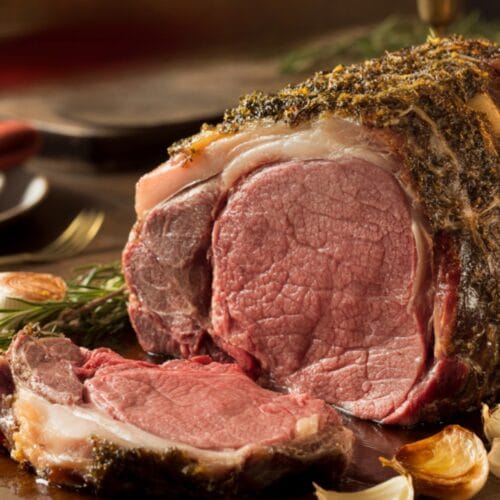
Classic Christmas Prime Rib
This Classic Christmas Prime Rib features a succulent bone-in rib roast coated with aromatic herbs and garlic, slow-roasted to perfection, and finished with a high-heat sear for a mouthwatering crust that will crown your holiday table with elegance.
Ingredients
- 1 5-7 pound bone-in prime rib roast (ask for the first cut or “small end”)
- 2 tablespoons kosher salt
- 2 tablespoons fresh ground black pepper
- 6 cloves garlic minced
- 3 tablespoons fresh rosemary finely chopped
- 2 tablespoons fresh thyme leaves
- 1/4 cup olive oil
- 2 tablespoons Dijon mustard
- 1 tablespoon Worcestershire sauce
- 2 tablespoons unsalted butter softened
Instructions
- Prepare the roast 24 hours ahead by removing it from packaging, patting it completely dry with paper towels, and placing it on a wire rack set over a baking sheet. Season generously with kosher salt on all sides, then refrigerate uncovered overnight. This crucial step creates a dry exterior that will brown beautifully and seasons the meat throughout.
- Remove the prime rib from the refrigerator 3 hours before cooking to allow it to come to room temperature. A cold roast will cook unevenly and require more time in the oven.
- Preheat your oven to 250°F (121°C) and position a rack in the lower third of the oven. Lower temperatures ensure gentle, even cooking for the perfect pink interior.
- Prepare the herb paste by combining the garlic, rosemary, thyme, black pepper, olive oil, Dijon mustard, and Worcestershire sauce in a small bowl. The mustard acts as an emulsifier and helps the herbs adhere to the meat.
- Pat the roast dry again, then rub the softened butter all over the surface of the meat, focusing on the top and sides where the fat cap is located.
- Apply the herb paste generously over the entire surface of the buttered roast, pressing gently to adhere. If your roast is tied, make sure to get some of the mixture between the strings.
- Place the roast bone-side down in a large roasting pan. The bones create a natural rack that allows air circulation and even cooking.
- Insert a reliable meat thermometer into the thickest part of the meat, being careful not to touch bone, which will give a false reading.
- Slow-roast until the thermometer reads 120°F (49°C) for medium-rare or 130°F (54°C) for medium, approximately 3-4 hours depending on the size of your roast. This slow cooking method ensures even doneness from edge to edge.
- Remove the roast from the oven and tent loosely with foil, allowing it to rest for at least 30 minutes. During this time, increase your oven temperature to 500°F (260°C).
- Return the rested roast to the very hot oven for 10-15 minutes until the exterior is deeply browned and crisp. Watch carefully to prevent burning the herb crust.
- Transfer to a cutting board and remove the kitchen twine if present. Carve by slicing along the bones to remove them (you can serve these separately), then slice the meat across the grain to your desired thickness.
Notes
- For best results, ask your butcher for a “first-cut” or “small-end” rib roast, which comes from closer to the loin and is generally more tender.
- The overnight salting (dry-brining) technique is essential for deep flavor penetration and moisture retention.
- If you don’t have a leave-in meat thermometer, check the temperature periodically, but try to open the oven door as infrequently as possible.
- Save the bones and any drippings for making beef stock or enhancing gravy.
- This roast can be prepared up to the slow-roasting stage several hours ahead, then finished with the high-heat sear just before serving.